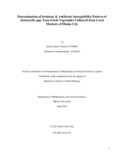Determination of isolation & antibiotic susceptibility pattern of Salmonella spp. from fresh vegetables collected from local markets of Dhaka city
Abstract
Many outbreaks of food-borne Salmonella have been connected to raw vegetables; however,
very little information is known on Salmonella contamination of raw vegetables in Dhaka's local
wet markets. In this research, isolation of Salmonella isolates & their antibiotic susceptibility
pattern were investigated. In total, 50 samples of raw vegetables were collected from the various
wet markets from Dhaka city. The samples with the highest level of contamination were tomato
(18%, n=10), green chili (18%, n=10), and mint (18%, n=10). The antibiotic resistance patterns
of the 55 Salmonella isolates recovered from those positive samples. After analyzing their
antibiotic resistance profile, it is found that 55 of those isolates are resistant to at least one or
more class of antibiotics, indicating that they are resistant to multiple antibiotics. Antibiotic
resistance and multi-resistance of Salmonella spp. have developed significantly during the past
decade, particularly in the developing nations where the use of antibiotics for human and animal
therapy has been increased. The rate of resistance observed for Penicilline and Metronidazole is
(100%) higher than all others. Followed by Clindamycin (98%), Erythromycin (95%),
Tetracycline (31%), Amoxicillin (48%), Streptomycin (10%), Chloramphenicol (15%),
Ceftriaxone (11%). Gentamycin, Co–Trimoxazole, and Imipenem has shown lower resistance to
this third generation antibiotics, rather than showing more susceptibility to Salmonella spp.
(98%, 93%, and 78%). This research had found that the contamination of Salmonella in raw
vegetables offers a potential risk to public health.

